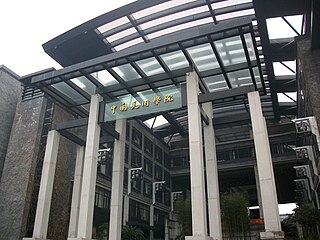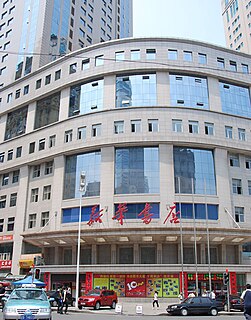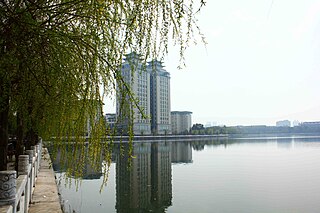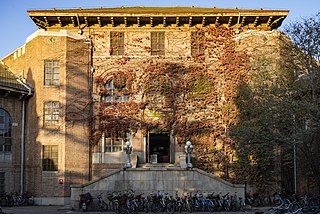
Tsinghua University is a national public research university in Beijing, China. The university is funded by the Ministry of Education. Tsinghua University is a member of the C9 League. It is also a member of Double First Class University Plan, Project 985 and Project 211. Since its establishment in 1911, it has produced many notable leaders in science, engineering, politics, business, academia, and culture.

Zhejiang University, colloquially called Zheda or abbreviated as ZJU, is a national public research university mainly based in Hangzhou, Zhejiang, China, with five urban campuses Zijingang, Yuquan, Xixi, Huajiachi, Zhijiang in downtown Hangzhou and three satellite campuses in Haining, Zhoushan and Ningbo, Zhejiang. The university is one of the most prestigious universities in China. Consistently ranked among top 5 academic institutions in mainland China, as of 2021, ZJU is ranked fifth in Asia and 45th globally by the QS University Rankings.

China Academy of Art, also translated as China National Academy of Fine Arts, was founded in Hangzhou in 1928 by the government of the Republic of China and the renowned educator Cai Yuanpei. It was the first art university and first graduate school in Chinese history. In 2016, the Academy has been approved to be jointly-administrated by Zhejiang Provincial Government, the Ministry of Education and the Ministry of Culture. It is a Chinese state Double First Class University Plan university.

China Youth University of Political Studies is a university in Beijing, established in 1985 by the Communist Youth League of China. Since then the university has been affiliated with the league, and the leader of the league usually holds the presidency of the university. Hu Jintao, the General Secretary of the Chinese Communist Party and President of China, was once the president of this university. The university's 12-hectare (30-acre) campus is located in Xisanhuan Bei Lu in Beijing.

Shen Yinmo was a Chinese poet and calligrapher.

The National Library of China is the national library of the People's Republic of China and is one of the largest libraries in the world. It contains over 41 million items as of December 2020. It holds the largest collection of Chinese literature and historical documents in the world. The National Library is a public welfare institution sponsored by the Ministry of Culture and Tourism.
The first libraries in China came into being during the time of the Shang dynasty as intellectuals known as the Shi (historians) and Wu (diviners) emerged from manual labor to special occupations for the creation and spread of culture. Among the documents that these occupations managed were "the country's statute books, genealogies of imperial kinsmen, issued notices and orders, and recorded important events and natural phenomena. For future verification and reference, they built storehouses to keep records in different media. To meet the needs of more and more complicated affairs and to ensure easy use, they began to collect and sort out those records according to chronological order and category. Thus, the earliest library in China came into being. The numerous kinds of media loaded with information and knowledge emerged in human society, resulting in the concepts of preservation and collection. Accordingly, the earliest libraries and archives were the result of conscious collection, process, coalition, and utilization."

Ningbo University is located in Jiangbei District, Ningbo, Zhejiang, China. It is a provincially governed key university in Zhejiang Province. It is a Chinese state Double First Class University Plan university, identified by the Ministry of Education.

The Huajiachi Botanical Garden, is a botanical garden of Zhejiang University.
Guanghua Law School is the law school of Zhejiang University in Hangzhou, Zhejiang, China.
Yang Guanghua or Guang-Hwa Yang, was a Chinese chemist and chemical engineer. He was the President of China University of Petroleum, and a pioneer of China's oil industry.

Xinhua Bookstore is the largest and only country-wide bookstore chain brand in China.
Wuhan Institute of Design and Sciences, formerly Chutian College of Huazhong Agricultural University (华中农业大学楚天学院) is a private university in Jiangxia District, Wuhan, China. It was initially established in 2006 as an affiliate college of Huazhong Agricultural University. It provides education in Food, Pharmaceutical, Art and Design, Information Technology, Business, etc. In March 2015, the school separated from its host university and changed to its current name.
Over one hundred officials of provincial-ministerial level and above have been implicated by the anti-corruption campaign in China, which began after the 18th National Congress of the Chinese Communist Party in 2012. The number of officials implicated below the provincial level are much higher. The tables on this list includes only officials for which a case has been initiated by the Central Commission for Discipline Inspection.
Zeng Jingsheng is a Chinese oil painter. He was born in Huizhou, Guangdong. He is a member of the China Artists Association. He has been vice chairman of the Shenzhen Artists Association.

Guanshan Subdistrict is a subdistrict in Hongshan District, Wuhan, Hubei, China. To the east it borders the Donghu New Technology Development Zone; to the south it borders Jiangxia District and the Third Ring Road; to the west it borders Zhuodaoquan Subdistrict ; to the north it borders the East Lake Nature Scenic Area. The subdistrict encompasses the campuses of more than ten universities including Huazhong University of Science and Technology, China University of Geosciences, South Central University for Nationalities, Zhongnan University of Economics and Law, and Wuhan Textile University (武汉纺织大学).

Tsinghua University Library System includes the Main Library and six branch libraries: Humanities & Social Sciences Library, Economics & Management Library, Law Library, Architecture Library, Fine Arts Library, and Finance Library. It has a total floor area of 70,000 square meters and provides more than 4,800 user seats. The Main Library, with a total construction area of 42,820 square meters, consists of the Old Library, West Library and North Library. The West and North Libraries are integrated harmoniously in style with the Old Library.

Haining Library, or Haitu (海图), is a public library affiliated to Haining Municipal Bureau of Culture, Radio, Television, Tourism and Sport. The library is located in Haining, Jiaxing, Zhejiang, China, with a main building located in 60-62 Xuelin Street and 11 branches and tens of circulation points located in all the towns and sub-districts under Haining. As of August 2018, the library contains 1.7 million item. It is ranked as National First Class Library by the Ministry of Culture and Tourism of China.
Wuhan Institute of Design and Sciences, formerly Chutian College of Huazhong Agricultural University (华中农业大学楚天学院) is a private university in Jiangxia District, Wuhan, China. It was initially established in 2006 as an affiliate college of Huazhong Agricultural University. It provides education in Food, Pharmaceutical, Art and Design, Information Technology, Business, etc. In March 2015, the school separated from its host university and changed to its current name.












